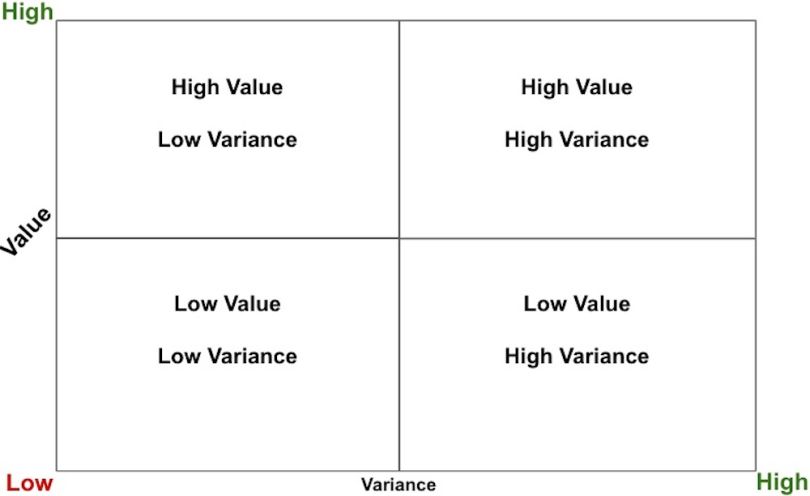At my previous startup, our executive team agonized over setting the right goals for the company and keeping the team focused on achieving our objectives. We had a bias for action, we were data-driven and we were committed to measuring what matters. As an executive team, we took seriously our responsibility to set the direction of the company, and we invested significant time in our strategy sessions. We weren’t just trying to check the boxes; instead, we believed we were doing the work necessary to lead our startup.
We spent a lot of time at off-sites poring over data, deliberating about customer needs and conducting thoughtful whiteboard exercises. But during our strategy sessions, we found three recurring problems. First, there were too many good ideas, and the volume became overwhelming. Second, even after all the quantitative and qualitative deliberations, the path forward still felt uncertain and unclear. Lastly, when we were reviewing previous projects, we often felt like we were spending too much time and energy with marginal results. We all felt like our real problem was that we didn’t have a process for making difficult choices and for prioritizing our objectives.
- There were too many good ideas, which can become overwhelming.
- We spent a lot of time and energy just to see marginal outcomes.
- The path forward seemed just as unclear as before implementing OKRs.
The Priority Problem
As I was considering this problem, I remembered an important maxim about strategy from my time in the Army: “You can have lots of supporting objectives, but you can only have one main effort.” If I were planning a mission for three groups, then one of them would always be the main effort. Their specific mission was tied to a decisive point, which was the key to winning the “battle.” The point of planning was to figure out what was decisive and then prioritize the actions and align resources accordingly. So, I started looking for a civilian version of this approach to bring to the leadership team.
I considered the three big goal-setting tools (OKR, OGSM and The Balanced Scorecard) but, by themselves, none of these really solved the problem. These tools are operational and tactical frameworks, and they help you get organized and execute. They will allow you to align effort, communicate openly and track your progress, but they don’t help you develop and prioritize your objectives. In fact, each of these methods assumes you can identify your objectives and prioritize them before inserting them neatly into the goal-setting framework.
For us, that wasn’t the case. Large companies have resources to develop and prioritize strategy including experienced executives, internal strategy teams or even consultants. It makes sense that many of the most popular frameworks are tailored to larger organizations that need help communicating across a large (and possibly distributed) workforce. But we needed a solution that fit our scrappy startup.
But then one day, after months of research, it clicked. I was reading a piece by Shishir Mehrotra in which he stated, “Framing is the process of breaking down a problem into a set of choices, trade-offs and options that enable a team to make a call and move forward.” I realized that we lacked the right framing for our strategic choices. We needed a prioritization framing as the solution to our three recurring strategy problems. This framing would give us a consistent decision-making process to help us allocate resources (time and money) to the most impactful projects that would substantially improve our business.

Frame It!
There are lots of ways to frame a problem. The multifarious nature of strategic framing can be just as overwhelming as the “too many good ideas” problem we were experiencing already. We clearly needed framing that would focus our prioritization debates in a way that the whole team could support.
After more research, I found this video from Dr. Sonia Marciano, a strategy professor at New York University. She walks through a particular strategic frame that helps companies maximize the impact of their strategy. Her thesis is that companies should seek to invest their time and money in projects that will produce the biggest return on their investment.
Her approach analogized strategy to the familiar realm of education. Think back to your days as a student. For the sake of this argument, let’s agree that your goal in school was to get the best grade you could. Each class had a syllabus that explained the different homework, group projects and tests that made up the final grade. For one of your classes, the syllabus indicates that tests are weighted more heavily than other assignments and account for 70 percent of the grade. The remainder of the grade is determined by group projects and homework, which account for 20 percent and 10 percent, respectively. As a student, you had other responsibilities and distractions, so you wanted to figure out where to target your time working and studying to get the best grade.
The weight of each assignment as a percentage of the final grade is a big clue as to what matters most to the teacher. Let’s imagine that the teacher only grades for completion on homework and projects. This rubric means that you need to do homework and group projects, but there is no extra credit for going above and beyond completing them. On the high-value assignments like exams, however, it matters a lot that you do the best you possibly can. Any extra effort here will be rewarded in terms of your final grade.
In this example, the student decides where to invest time and resources (prioritizing strategy) based on the weight of the assignment (value) against how much differentiation (variance) there is in the outcomes of those assignments. We can plot value and variance on a graph and develop a two-by-two grid.

Variance and Value
Variance is an approximate measure of how differentiated the results are. In this example, for homework and group projects, the potential range of outcomes is binary, meaning the student either did the homework or didn’t. Accordingly, the range of outcomes is narrow, meaning these assignments have low variance. By contrast, the exams have high variance because the potential range of outcomes is wide.
Value is the measure of how much impact the outcome has on your goal. In this example, the teacher expressly told students exactly how much they valued each assignment by giving it a percentage of the overall course grade via the syllabus. Tests were 70 percent of the final grade and therefore have the highest value.
The student can use this simple grid and the value versus variance framing to prioritize how to spend their time studying. If an assignment has high value and high variance, as the exams do, then the student should over-invest in this assignment and prioritize it highly. Conversely, if an assignment has high value and low variance (group projects) then all that matters is that you do it satisfactorily. Hence, the student could under-invest time in group projects and use that extra time to study for the exams.
The value versus variance framing will clearly prioritize the initiatives, projects and ideas that have the ability to return more money in revenue and profits than costs to deliver. This framing will tell you where to over-invest your resources (High Value/High Variance) and where to harvest resources and underinvest (Low Value).
Optimize Your Plans
We can translate this school analogy and apply it to startup business strategy. Much like the student who is optimizing his time and effort to get the best grade, your company is using the value versus variance framing to optimize for the most important thing for your business. This is your decisive point.
You are the student and the teacher is an amalgamation of your best customers. Your goal now is to figure out how your best customers grade your business. The assignments are replaced by unique value propositions (UVP), which are attributes that customers use to differentiate between you and your competitors. They show why a customer would choose your product or service over another. Variance measures how a discerning customer will grade your delivery of the UVP.
Your overall success is now a function of how quickly and effectively you can identify how your best customers will grade your business. If you know what matters to your customers, how much it matters and whether or not you can earn extra credit, you can objectively prioritize projects that align directly to the most important unique value proposition in the eyes of your customers.
Get Busy Framing
Let’s walk through how this would play out in a leadership off-site where your team is organizing and prioritizing objectives. One team member advocates for investing heavily in new technology for the customer service team to help improve response time and customer satisfaction. Another team member advocates for investing in the supply chain to help reduce costs. Both are great objectives in the abstract. We can use our framing to help determine which project should receive priority. In this example, imagine that our company has the best reputation for customer service and is willing to pay a premium for that service. In this case, it’s obvious that you could save the resources for the supply chain project and over-invest in customer service. Your customers have told you that they value your service more than the price.
OKRs, KPIs and all the associated alphabet soup of goal-setting frameworks are solid tools once you have determined and prioritized your company’s objectives. Before those tools can be useful, however, your team will need to think like our hypothetical student. Under-invest in parts of your business that customers don’t value. If the customer expects you to “just complete” the delivery of value, then good enough works. Over-invest in the parts of your business that are the most valuable to your customers and for which you earn a reward for exceeding expectations.
If you can implement this framing and apply it to your company’s objectives, you’ll have a definitive way to settle debates on strategy. You will have a clear path for the future of your company’s development based on what your customers value. Good ideas that aren’t aligned to customer value can be placed on hold, and the projects that drive the most value for customers get priority.





